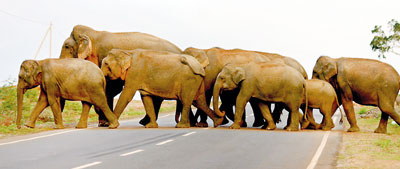News
Development out of step with conservation in Hambantota
Non- implementation of The Managed Elephant Range (MER) puts wildlife in general and elephants in particular in peril
Grand are the plans for Hambantota, including Mattala as a ‘showpiece’ where development and conservation work together well, but ground-level reality is a far cry from what it should be. The Managed Elephant Range (MER) was very much part of the plans for Hambantota development. However, unplanned development and non-implementation of the MER may spell disaster for the “green airport” concept that the authorities are keen to promote with regard to Mattala, and the grand tourism development plans under way, the Sunday Times understands.

Where will they end up? Elephants crossing a new road in the MER
The MER is a vital component of the Strategic Environmental Assessment (SEA) carried out by the Central Environmental Authority (CEA) and the Urban Development Authority (UDA). This was in connection with the ‘zoning of land’ for the Greater Hambantota Area, taking into consideration development needs until 2030, as well as conservation issues.
Covering 150 sq.km or around 15,000 hectares (downsized from the 300 sq.km originally planned), the proposed MER is expected to encompass the Gonnoruwa-Wewegama-Mattala areas and extend up to Kumaragama-Bodagama. There would be a perimeter electric fence around the MER to prevent elephants from entering developed areas around it. Meanwhile, villages and permanent cultivations within the MER would also be helped to protect themselves from elephant depredation, it is learnt.
Within the MER, development activities compatible with elephant presence would be continued, and activities such as elephant-viewing based tourism promoted. This is the difference between an MER and a Protected Area (PA), where all development activities are excluded, the Sunday Times understands.
Although, about 10% of the country’s elephants, amounting to 400-500, are in the proposed MER, no action is being taken to implement it, wildlife activists pointed out. In an MER, the status quo between people and elephants remains, and there is human-elephant co-existence, a source said, stressing that the way things are going, the exact opposite would occur.
While the planned development includes the airport and the port and connected infrastructure, there is huge unplanned development such as encroachment by single families as well as mudalalis, and large companies, another source said.
Various government institutions are also disregarding the zoning plan and allocating lands within the MER, on whims and fancies, for unsuitable development activities, he pointed out.
“This poses a great threat to elephants in that area, and will cause an escalation in the human-elephant conflict (HEC),” the source explained, adding that, if it goes unchecked, the elephants would become the victims, but not without a fight, which would cause much misery and suffering to thousands of people.
This would also be a major threat to planned development and jeopardise the ambitious tourism development centred around the Mattala Rajapaksa International Airport and Hambantota, it is understood. Citing the example of elephants breaking through the electric fence around Mattala airport and getting into the premises, another activist said, unplanned development and encroachment by people into elephant areas would make them more aggressive and lead not only to more frequent but also more violent ‘breakthroughs’.
The encroachments are also resulting in more elephants getting seriously injured due to snares being set for other wild animals, or falling into wells and dying. Earlier, elephants were tracked and data collected which was used by both the CEA and the UDA in the zoning of Hambantota. Now, however, everything is static. There is no long-term plan for monitoring and managing the elephants, or the mitigation of the HEC, it is learnt.
Many who remember the Walawe left bank development scheme and the disastrous consequences of driving the elephants into the Lunugamvehera National Park in 2006, reiterated that the HEC did not abate. Instead, the HEC increased, with the remaining elephants becoming more aggressive and resisting being chased. This caused severe problems to the people there.
Driving the elephants again, instead of managing them within the MER, will fuel more conflict, a perturbed wildlife enthusiast said.
The negative impacts of the Walawe drive on elephants were also severe and long-lasting – some elephants died during the drive and others died of starvation in the Lunugamvehera National Park. Lunugamvehera became an elephant graveyard, and babies still die of starvation every dry season, even after six years, it is learnt.
“Don’t let the elephants in Hambantota including Mattala, go the same way to an untimely death,” plead animal rights activists.
Follow @timesonlinelk
comments powered by Disqus

